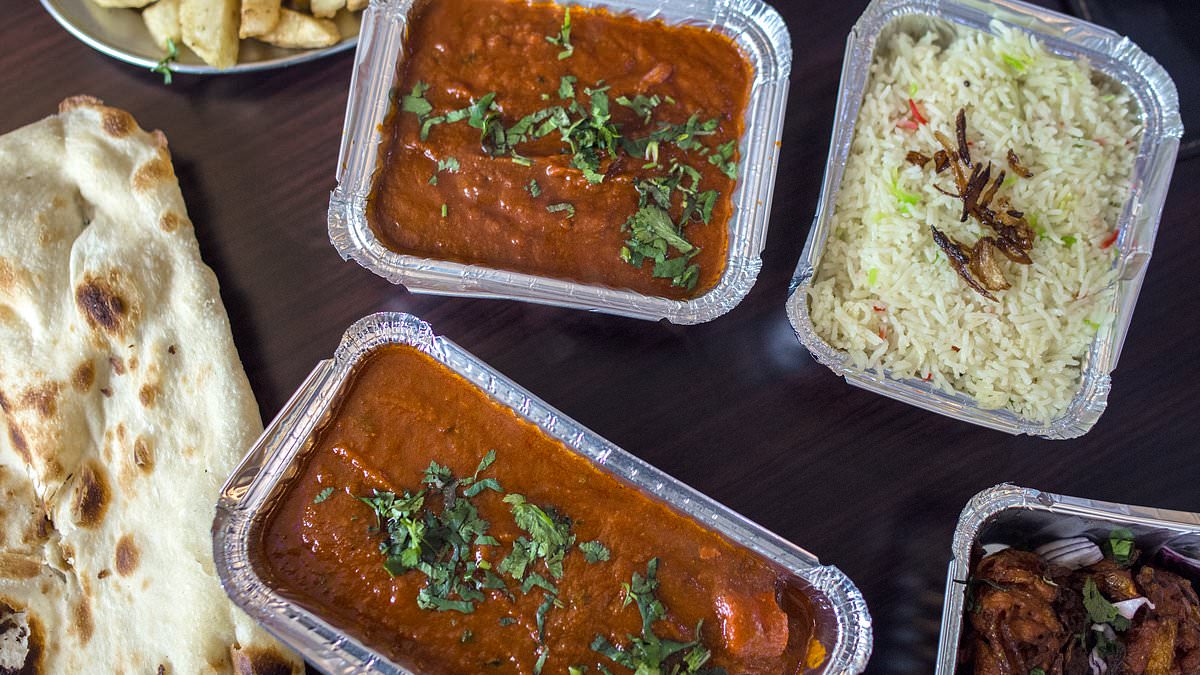Copyright dailymail

Nutrition experts reveals the healthiest things to order from your local Indian takeaway READ MORE: Fancy a Chinese tonight? These are your healthiest options By EMMA GRITT, ASSOCIATE HEALTH EDITOR Published: 10:43 BST, 25 October 2025 | Updated: 12:02 BST, 25 October 2025 Indian food is one of the most fragrant and moreish on Earth—and thankfully we don't need to travel nearly 5,000 miles to enjoy it. With an estimated 8,000 Indian restaurants and takeaways across the UK, the country's huge array of dishes and cooking styles—plus the milder, creamier dishes created especially to cater for Britons' palates—are easily accessible. And, it's good news for people who love a Friday or Saturday night curry, Indian food can be nutritiously dense—if you're ordering the right dishes. Vince Kelly, a culinary lecturer from Capital City College and member of Culinary Medicine UK, told the Daily Mail that he regards it as one of the healthiest takeaway options. He said: 'Indian food is rich in spices with anti-inflammatory properties, vegetables, pulses, and lean proteins. 'One of the best things about an Indian takeaway is the array and vibrancy of spices and colour that it brings to the plate. 'If you have ever heard of the "30 different plants a week" rule, it includes not just fruit and vegetables but also spices and having a portion of Indian food definitely contributes to the variety we have in our diet.' Along with the iconic curry, many Indian dishes are cooked in a 'tandoor', a cylindrical clay oven which roasts meat as it hangs over hot coals. Ordering an Indian can be a healthy treat, if you listen to our experts' advice Emily Lenoir, Registered Associate Nutritionist (AfN) & Behaviour Change Coach at Voy echoes the sentiment, adding that Indian food's natural reliance on pungent, anti-oxidant rich spices such as turmeric, cumin, ginger and fenugreek have been scientifically proven to benefit our health. She told the Daily Mail: 'Curcumin in turmeric may help reduce inflammation, ginger can support gut health and cardamom may aid blood sugar regulation. 'Together, these spices enrich meals and, when used regularly, contribute to long-term wellbeing. Man, 57, who spent £100-a-day on takeaways unrecognisable after losing 8 stone without weight loss jabs 'Equally important is Indian cuisine's reliance on fresh vegetables, lentils, legumes and whole grains, providing fibre, plant-based protein and micronutrients such as iron, folate and zinc. 'Many traditional dishes are naturally balanced, combining complex carbohydrates, lean proteins and healthy fats, and often include fermented foods like yoghurt or dosa batter—pancakes made from rice and lentils—that promote a healthy gut microbiome.' Mr Kelly agrees, telling us that Indian cooking hasn't only been developed by flavour but as a system of function. 'Key spices such as turmeric, cumin, coriander, ginger, garlic, fennel, fenugreek, mustard seeds, cardamom, cloves they not only are wrapped in aroma and complex taste, but have varying digestive, antimicrobial and anti-inflammatory effects,' he said. However before you take the experts' enthusiasm for Indian food as carte blanche to tuck into a takeaway curry every night, Mr Kelly is keen to stress that when it comes to ordering in, you can't be sure you're your getting the cuisine's full benefits... but you can be sure you're getting a lot of fat. Be the first to commentBe one of the first to commentComments What's YOUR go-to Indian takeaway order? Comment now Some of the most iconic Indian dishes are cooked in cream or ghee—but there are alternatives Much Indian food relies heavily on coconut oil, cream and ghee, a form of clarified butter. The NHS advises that no more than 35 per cent of our daily calories should come from fat—around 30g per day for men, and 20g per day for women—with a maximum of 11 per cent coming from saturated fat. Fat is vital for helping the body absorb fat-soluble vitamins A, D and E, and is also converted into energy. However, eating too much fat can lead to obesity, which an increasing number of scientific studies has linked to a string of serious, life-limiting health conditions including obesity, heart disease, and dementia. Scientists confirm a simple 16p-a-day supplement boosts weight loss and burns belly fat - but they're NOT safe for everyone 'Indian takeaways now and then are not the problem they are flavour dense, satisfying and a great meal to enjoy, but they use far more salt, fat and oil than we would typically use at home' Mr Kelly said. 'The issue is frequency, when rich takeaways become routine, the repeated intake of excess calories and saturated fat accumulates over time and that is when risk builds.' Thanks to its abundant culinary heritage, there are a myriad of ways to make your dinner delivery veer more towards healthy than hedonistic. Both experts the Daily Mail spoke to suggest focusing on small switches, choosing veg or fish over red meat, ordering only pilau rice or naan is a fast way to reduce calories—or swap them for steamed rice and a wholewheat chapati. Aloo gobi, a dish made from spinach and potato made the experts' healthier option list Ms Lenoir said: 'The calories from popular sides can add up quickly. 'A Peshwari naan typically has about 500 calories, and a portion of pilau rice, can have around 450 calories when fried in ghee.' Similarly, consider the sauce your dish comes in. Could you swap creamy gravies for tomato-based or tandoor options? With a typical Indian takeaway menu in mind, we asked Mr Kelly and Ms Lenoir to identify the healthiest choices, and the notoriously calorific dishes to avoid. Chicken tikka or tandoori Not to be confused with an iconic chicken tikka masala—which has been voted Britain's favourite dish countless times—this dish doesn't come swimming in an oily skinned, creamy red sauce, but is served dry. This, explained Mr Kelly, is a healthy dish because of how it is prepared and cooked. He said: 'It's yoghurt marinated, spice rubbed chicken which is cooked run a tandoor or grill with no added oil. Sadly for chicken tikka masala lovers, it's not one of the healthiest choices 'Because it is not simmered in a butter or cream-heavy sauce, the calorie load stays low while still delivering high quality lean protein.' Ms Lenoir agrees, adding that the dish—which is usually around 350 calories per portion—is high in protein and fibre while being naturally low in saturated fat. Vegetable curries Swapping meat for fish or vegetables is one of the experts' top tips for making your Indian takeaway healthier, and you can also explore some of the country's incredible vegetarian dishes. It's estimated that nearly 40 per cent of Indian population is vegetarian, so when it comes to vegetable dishes, they truly know their stuff. Mr Kelly said: 'A baji—not to be mistaken with a deep fried bhaji—is a sautéed or lightly stewed mix of vegetables cooked with spices rather than batter and oil. 'This gives you gut-boosting fibre, volume and micronutrients without the heavy calories of rich curries.' Ms Lenoir agrees, and names chana masala, a dish made from chickpeas simmered in tomato and onion, as her top pick. Watch out for naan breads, they can add hundreds of extra calories Speaking of the dish, which is around 350 calories per serving, she explained it provides iron, folate and plant-based protein, supporting heart and digestive health. She added: 'Tomato-based curries like vegetable jalfrezi (300-450 calories per serving) are rich in antioxidants such as vitamin C, while mixed vegetable curries offer a rainbow of nutrients that support immune and metabolic wellbeing.' Daals are a form of soup or stew made from dried, split pulses such as lentils, peas, and beans, and flavoured with an array of spices. Usually served with rice or roti—a traditional flaked bread—they are a staple food on the Indian subcontinent and within the diaspora. The famous variety, dal tadka, a spiced lentil curry which is naturally high in protein and fibre while being naturally low in saturated fat, typically contains just 280 calories. Mr Kelly also speaks highly of dal, least of all as they are 'one of the most climate-friendly choices' on the menu. He said: 'Lentils provide plant protein plus soluble fibre that slows digestion, improves fullness and benefits cholesterol. Creamy and oily curries are to be avoided, opt for a bhuna instead 'Unlike cream-based curries, daals are water-based and naturally lower in fat.' One of the most famous Indian dishes of carefully spiced potato and spinach, saag aloo is a winning choice when ordering in. It uses modest amounts of oil, and is flavoured with antioxidant-packed spices cumin, mustard and asafoetida—made from fennel root—along with a generous dose of garlic and ginger. Mr Kelly said: 'The leafy greens supply iron, folate and antioxidants while the fibre from both the spinach and potato moderates blood sugar absorption. 'It is flavour dense without being calorie dense.' You can expect a portion of saag aloo from a takeaway to clock in at no more than 350 calories. Bhuna curries If you're worried that curries are off the menu then don't fret—you can still indulge, as long as you keep away from creamy and oily sauces. Dry curries and daals are good if you're looking for high nutrient and low calorie options 'Creamy curries like chicken korma or butter chicken can reach 800–900 calories per serving, mainly from cream, butter and nuts,' explained Ms Lenoir. 'Similarly, lamb rogan josh is flavourful but often higher in saturated fat when prepared with fatty cuts of meat.' Mr Kelly agrees, citing both types of dishes as good nutrition no-no's. 'The most calorie-dense items on the menu have cream, butter and sugar leaning gravies, combining saturated fat with curry pastes that can be high in refined sugar.' Experts share the herbs and spices which can improve your gut-health... and the best way to eat them This combination means high levels of saturated fat and a spike in blood sugar. Dishes which involve cooking lamb long and slow can also be a calorific bomb—a lamb rogan josh can reach 600 calories per serving. This is because lamb can release and retain fat, and it's often served in thick oil-based gravies, making the dishes even richer. But if you can't skip curry, Mr Kelly advises choosing a bhuna dish, which usually hover around the 350 calories per portion mark. What is referred to as a 'dry curry', the base of the dish are fried down onions and tomatoes, with meat or vegetables added in. To finish, it is baked in the oven, causing the sauce to cling to the meat rather than leaving it floating in oil or cream. 'This 'reduction instead of enrichment' technique creates intensity without adding fat,' explained Mr Kelly. 'You get robust flavour at a lower caloric cost.' Share or comment on this article: Nutrition experts reveals the healthiest things to order from your local Indian takeaway Add comment



